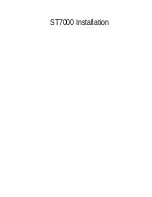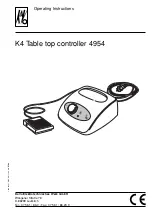
Appendix A: Interface 1000 Specifications--Floating Operation
Appendix A - 4
General
Power Input Voltage
Range 46 to 50
volts
Power
Max
75
W
Leakage Current
(Floating, Earthed Working Electrode)
±1 nA
Note 22
Dimensions
24 × 27 × 6
cm
Note 23
Weight
Max
2.0
kg
Note 23
Dimensions of External Power Adapter
Max
13 × 6 × 3
cm
Note 24
Weight of External Power Adapter
Max
300
grams
Note 24
NOTES:
1.
Measured in galvanostatic mode with a high-power 200
Ω
load connected from counter electrode
lead to the working electrode lead. The compliance voltage is measured using an external voltmeter
across the 200
Ω
load. Under these conditions, the output current is approximately 115 mA.
2.
Measured with a precision 4-terminal 2
Ω
load, in potentiostatic mode.
3.
Unity-gain bandwidth and slew rate are correlated. Each has five settings, with the highest slew rate
occurring at the highest bandwidth, down to the lowest slew rate occurring at lowest bandwidth. Both
are measured with 20 k
Ω
between counter and reference, and 100
Ω
between the reference and the
working and working sense leads.
4.
Measured with an external function generator connected to the Ext Sig In BNC.
5.
The A/D and signal-processing chain in the Interface 1000 allows measurement of voltage signals as
large as ±13.107 V. The voltage on the working sense lead can be as high as ±0.4 V when measuring
1 A using a 60 cm cell cable. This implies a maximum voltage input on the differential electrometer of
±13.6 V.
In practice, the operational amplifiers in the voltage-signal processing circuitry cannot guarantee
voltages beyond ±12.5 V.
6.
This specification is tested using a 2 G
Ω
resistor switched into the input and measuring the voltage
difference with and without the input resistance.
7.
The differential impedance is measured between the reference and working sense inputs. This is the
impedance you measure when you record the EIS spectrum of an infinite impedance (open-lead) cell.
There is also a common-mode resistance and capacitance associated with the differential electrometer
inputs. These values tell you how much the electrometer response is modified by a resistance in series
with the source.
8.
The bandwidth is for a sine-wave source with a 50
Ω
output impedance driving either input. The
bandwidth is well in excess of this specification, which is limited by the measurement equipment used
in routine testing of the Interface 1000.
9.
CMRR is common-mode rejection ratio. It specifies the ability of the differential electrometer to reject
signals connected to both inputs. The CMRR is measured driving both inputs with a sine-wave source
with a 50
Ω
output impedance, and measuring the error as a function of frequency. Resistance in
either input causes a loss of CMRR.
10.
Voltage measurement is performed with a nominal
3 V signal input to the ADC signal chain. The
actual full scale is 3.2768 V. A
4 attenuator divides down higher-voltage electrometer outputs so they
fit into a
3 V input, thus making a
12 V nominal (13.1072 V) actual full-scale range.
Содержание Interface 1000
Страница 8: ......
Страница 18: ......
Страница 36: ...Chapter 4 Cell Connections Membrane Cell Connections 4 4...
Страница 44: ...Chapter 5 Panel Indicators and Connectors Rear Panel 5 8...
Страница 62: ...Chapter 8 Measurement of Small Signals Floating Operation 8 8...
Страница 68: ...Appendix A Interface 1000 Specifications Floating Operation Appendix A 6...
Страница 70: ...Appendix B Interface 1000 Cell Connector Floating Operation Appendix B 2...
Страница 78: ...Appendix E CE Certificate Appendix E 2 Low Voltage Certificate of Conformance...
Страница 79: ...Appendix E CE Certificate Appendix E 3 RFI Certificate of Conformance...
Страница 80: ...Appendix E CE Certificate Appendix E 4...
Страница 84: ...Appendix F Heat in Interface 1000 MultEchem Systems Appendix F 4...
















































